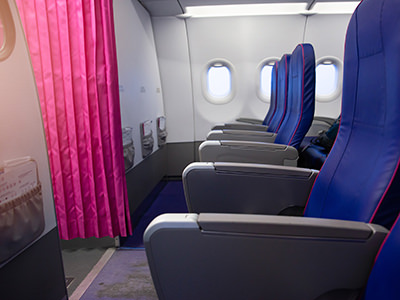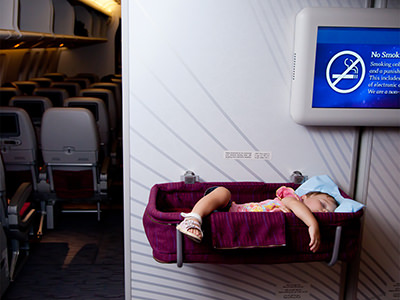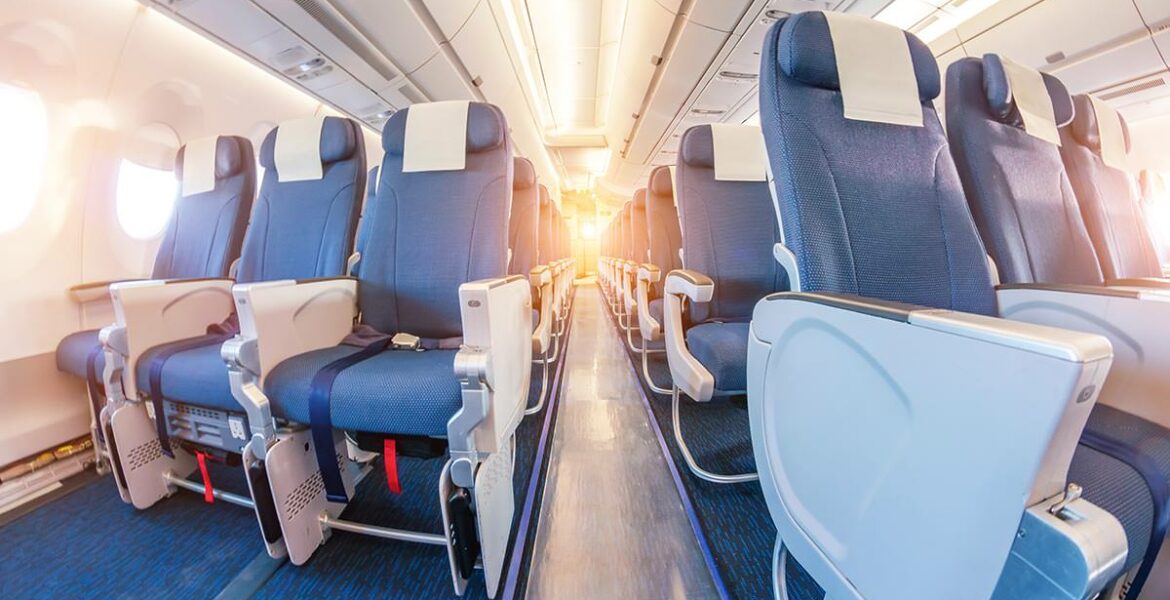Discussions about the best seat on a plane are as old as commercial aviation. Some passengers travel only in business class. There are passengers who make the controversial choice of picking the last seat on the plane. Others do not consider anything but seats that provide extra legroom. Today, we’re going to take a deep dive into a very specific part of the aircraft. What are the advantages and disadvantages of the bulkhead seat on a plane? These are the most frequently asked questions about airplane bulkhead seats, one of the most special rows on the aircraft seat map!
Bulkhead definition
A bulkhead is defined as an upright partition separating compartments (Merriam-Webster). Essentially, it is a wall or a barrier that divides sections of a plane, ship, or any other vehicle.
Why do they call it bulkhead?
The word bulkhead originates in the Old Nordic word for cargo – bulki. Shipbuilders call vertical panels – heads. So the bulkhead in medieval Europe aimed to prevent cargo from moving around the ship.
However, there are earlier records of the bulkhead construction in China (5th century) that shed light on the compartmentalization of the ship’s bottom in watertight sections, which prevents sinking even in the case of a leak.
If you were wondering about Titanic, the answer is: yes, it had 15 bulkheads. While nominally watertight, they did not seal at the top, which caused the overflowing of water from one compartment to another. Also, not closing certain doors helped the progress of the tragedy.
What is a bulkhead seat?
Bulkhead in an airplane has the purpose of dividing the cabin into sections, typically for separating different classes of service (economy, premium economy, business, first class, or any combination of these). This divider also enables the installation of galleys, lavatories, and crew areas.
But you are wondering: what is a bulkhead seat? How can we define this type of seating?
The bulkhead seat is the one located directly behind the bulkhead of a plane. It means the bulkhead seat is in the first row of that section.
Beware, seats in front of the bulkhead wall are not considered bulkhead seating! Those are just the last row seats of that section of the aircraft.
Where is the bulkhead on a plane?

On smaller planes, and on shorter domestic flights, there will be only one, “soft” bulkhead division between business class and economy class, at the front part of the aircraft. It typically comes in the form of a visual fence – like a curtain, or combined with a half wall.
But for the purpose of this guide, we are focusing on long-haul flights. On these, there will probably be several bulkheads, dispersed throughout the aircraft and dividing it into sections.
However, there is no unison. The seating plan for Airbus A320 and Airbus A321 might not offer the same bulkhead seats. Plane types are not even the only element defining the design of the interior! It also depends on the airline operating a particular aircraft.
Always check the aircraft seat map if you want to locate where is the bulkhead on a plane you are flying with. To find out how to do that, keep reading, or scroll down to the question “How to get a bulkhead seat on a plane?”.
What does a bulkhead seat look like?
At first glance, standard and bulkhead seats in an airplane do not seem to be unlike.
The first obvious difference is the view. When sitting in a bulkhead seat, you are directly facing a wall.
But if you take a better look, you will notice other parts of the bulkhead seat design are also affected by its position in the plane.
When sitting in bulkhead seats, you are compromising space for your hand luggage, for your hips and thighs, and possibly even feet
For instance, you will typically not find space under the airplane seat in front of you, simply because there is no such seat. It might be different on flights where classes are separated only by a semi-curtain. But most long-haul flights will only put a firm wall in front of you, with no additional cutout space to stretch legs or store personal belongings, which standard seats do enable.
Space for feet and luggage is not the only one missing. Bulkhead seats also don’t have an open space under the armrest. While in regular seats you can always lift the armrest and possibly snuggle with your partner, or even catch a nap on a free seat next to you, this is simply not possible in bulkhead seats. Armrests come in full, solid form, and they are immovable.
Why is that, you ask yourself? Read on!
Do bulkhead seats have tray tables?
Yes, bulkhead seats have tray tables. As there are no seats in the front where they would normally be attached, tray tables at bulkhead seat rows are stored exactly in those fixed armrests.
They fold out of the armrest, and unlike the tray tables for regular seats, which have adjustable positions depending on how close you want them to be, bulkhead seats’ tray tables can hardly be manoeuvered. Due to the position of the armrest, these tray tables are lower toward the legs and closer to the abdomen.
Additionally to their inconvenient positioning and smaller size, the foldable design and attachment to only one side of the bulkhead seat make these tray tables wobbly in comparison to sturdier tray tables at regular seats.
Do bulkhead seats have TV screens?
If there is an inflight entertainment system (IFE) on board, then the passengers sitting in bulkhead seats will also have personal TV screens.
In one version, those screens will be mounted on the bulkhead wall in front of the seats. The screens are the same size as those mounted on seatbacks, but are further away, which makes using the touchscreen function and watching content harder and less convenient.
Alternatively, IFE screens could also pop out of the armrest. Those could be awkwardly positioned and clumsy to use too. Because of the safety measures, they will have to remain stowed during the taxi, take-off, and landing. It means bulkhead seat passengers usually have a reduced inflight entertainment time when compared to passengers sitting in regular seats.
Is the bulkhead seat narrower?
The bulkhead seat is somewhat narrower than the regular seat. The placement of the tray table and TV screen in the armrest makes it bulkier. But no, the bulkhead seat did not get its name for that reason.
The consequence of wider armrests is reduced seat width. While the difference could seem insignificant (maybe 1 centimeter or half an inch), the fact that armrests of bulkhead seats have solid side walls affects the feeling of roominess for wider hips.
If you are a plus-size passenger, you will want to read our full guide to flying while fat! On the other side, if you're concerned about sharing a row with a larger passenger, read these strategies for securing your personal space against invasion!
Do bulkhead seats have more legroom?
While many online resources say that bulkhead seats on a plane come with additional legroom, I’d be careful with such claims. This largely depends on the airline and the aircraft, and could actually be completely untrue.
You see, there is a reason why airlines ask bulkhead seat passengers to store their personal belongings in the overhead compartment during take-off and landing. This is mandatory even when bulkhead seats are not exit-row seats.

The safety precaution is not there to protect the evacuation path for other passengers but for bulkhead seat passengers. It refers to the fact that objects might fly around if not adequately stored, but it also tells us that bulkhead seat passengers have less space to evacuate smoothly. This is not the case with regular seat passengers who could evacuate with personal belongings beside their legs.
The legroom at bulkhead seats might be nominally larger than at regular seats, but only for 7 to 18 centimeters (3 to 7 inches). However, don’t forget that when sitting behind a regular seat, your legs are using the space under the seat in front of you too, while at bulkhead seats there is a solid wall limiting feet stretching. Essentially, with bulkhead seats, you get more knee room, but it does not necessarily equal more functional legroom.
To make themselves comfortable, you will see some passengers using the bulkhead wall as a footrest. The reason for that might not be just their rudeness, but also – the discomfort of bulkhead seats.
Where do you store your carry-on when sitting in bulkhead seats?
With no floor storage, the only available space for storing your personal luggage when seated in a bulkhead seat remains the one in the overhead bins.
While you can keep your belongings next to you when cruising at high altitudes, they will need to be stored whenever the fasten seatbelt sign is on (taxi, take-off, turbulences, landing).
Be aware that sitting in the bulkhead row comes with a set of disadvantages when speaking about available space in the overhead compartments.
First of all, if those are overstuffed with other passengers’ carry-ons, your only alternative will be looking for available space in rows behind you. Passengers sitting in regular seats can look for available space both in front and behind their row.
Additionally, overhead lockers of the first rows are some of the most convenient places where flight attendants can easily store and reach emergency equipment, props for safety presentations, newspapers, extra pillows, blankets, and even their own suitcases.
All of that could affect the availability of space in overhead compartments for hand luggage of passengers sitting in bulkhead seats.
In the unlikely event of an emergency evacuation, you should always leave your baggage behind! That is the main proven way of surviving a plane crash!
Do bulkhead seats recline?
Normally, you shouldn’t have any problem reclining your bulkhead seat. Technically, you can expand your passenger’s space with reclining if you like, even if those flying behind you might not be happy about it.
One of the greatest advantages of bulkhead seats is that there are no seats in front of them, so there would be nobody reclining into your space while you are trying to eat, watch a movie, or work on a laptop. Regular seat passengers have to withstand that annoyance.
Do bulkhead seats have windows?
Normally, bulkhead seats have windows just like all other regular seats in the plane. In some cases, windows could be misaligned with the seats.
One should be careful if booking the bulkhead window seat that also happens to be in the exit row. In that case, window access might be harder, and the protruding part of the escape slide, stored in the exit door, might affect your feet’s comfort level.
Bulkhead leading to bathroom or galley
Depending on your preferences and metabolism, sitting in proximity to plane loos or food stations might be considered an advantage or a disadvantage.
Kitchen galleys and plane restrooms might provide easy access to these services, but could also be a source of light, noise, or smell pollution escaping the half-closed curtains.
While not having seats in front of you sounds almost perfect if you prefer to sleep on the flight (no seats = no bothering reading lights), distractions coming from behind the bulkhead wall could be equally annoying.
You might get your meal before the other passengers, and stay assured that food choices would not run out before the staff reaches you. However, you also need to accept the fact that flight attendants will pass by very often, and their carts could accidentally bump into your aisle bulkhead seat, simply because it’s the first one.
Other passengers could also congregate next to your seat, while queuing for the lavatory, approaching the staff in the galley, or just stretching out in the roomier part of the plane.
For flying parents, the proximity of galleys means easier access to food preparation areas as well as flight attendants whom they might need assistance from. In case the bulkhead row is next to the lavatories, bulkhead seats reduce the stress when one needs to plan diaper changing. However, busy areas of galleys and toilets might also be enemies of your kid’s nap, so it’s a double-edged sword you need to be aware of.
Can kids sit in bulkhead?
Yes, kids can sit in bulkhead seats. As a matter of fact, bulkhead row is often designed to accommodate families with children.
Bulkhead seats normally come with additional oxygen masks (this might not be the case with all regular rows), which is required if you are flying with a lap infant (typically babies and toddlers under the age of 2).
If you have small children, bulkhead seats could be your number one choice. But if you don’t have small children, and have issues with the sounds they produce, find a quiet corner in another part of the aircraft
Long flights are troublesome for holding an infant, and as bulkhead seat armrests are fixed, you cannot expand your space over two seats even if you book them.
The solution for smaller children is called: bassinet seats. Also known as a cot, carrycot, skycot, or basket, a bassinet seat is a small airplane bed designed for babies.
It can be mounted on the bulkhead wall during the cruising period, relieving your arms of holding the child for hours. As bassinets come in a variety of designs and safety levels, on some planes you will need to hold the child during turbulences.
Keep in mind that different airlines have different policies for assigning bulkhead/bassinet seats to passengers with kids, and you should contact them beforehand. For instance, if there is a wheelchair passenger on board, you might have to move to another seat.
When you travel with children, it is always good to bring plush toys. Learn how weighted stuffed animals can calm (not only) the youngest travelers!
How big is the airplane bassinet?
The size of the bassinet varies from airplane to airplane, from airline to airline. But on average, the use of an airplane bassinet has the child’s weight limit somewhere between 8 and 16 kilograms (18 to 35 pounds), or if measuring height – between 70 and 80 centimeters (27-31 inches) maximum.
Some airlines could also have an age limit in place, putting the bar for bassinet use on their flights anywhere between 6 months and 2 years of age. Always double-check the rules with the airline you are flying with!

Most airlines will let you use only the provided airplane bulkhead bassinets. If you are considering taking your own bassinet (or even a car seat) on the plane, check in advance that it meets safety and size requirements.
Reducing stress when flying with children
Another benefit is that you can more easily pass the baby and accessories around in the roomier area of bulkhead seats (assuming that you are traveling with a partner or a companion).
Bulkhead seats also reduce your stress of facing annoyed passengers whose seats your growing kid keeps kicking. There are simply no passengers sitting in front of you to worry about.
However, if your little one goes berserk when you cut his cartoon short, rethink whether sitting in the row where TV screens must be stowed much earlier before landing is the best idea for your family.
Technically, as it is the first row of the section, you could count on quicker deplaning once you landed. This can significantly calm a nervous child.
Sitting next to your children has become a privilege at some airlines, a privilege they are ready to charge extra for. Here's how to avoid junk fees in travel industry!
Are bulkhead seats more expensive?
More often than not, bulkhead seats are indeed pricier than regular seats. The mere fact that they are nominally offering larger legroom space entitles airlines to charge extra when selling bulkhead seats.
Are bulkhead seats worth it?
As you can see, one has to take a lot of things into account when trying to decide if bulkhead seats are a good, better, or worse choice. Like any row in the plane, bulkhead seats have their pros and cons. So why might some passengers prefer seats from the bulkhead, and why might some passengers avoid them at any cost?
Advantages
- Nobody reclines into your personal space.
- Potentially larger legroom (not guaranteed).
- Proximity to the lavatories or galleys, pragmatic access whenever you need to go, without needing to queue.
- When food is served, bulkhead seat passengers will typically get their meal before other passengers and can count on having the largest selection of available food and beverages.
- Accommodating families with small children.
- Quicker deboarding.
Disadvantages
- Facing a wall might not excite those with claustrophobic tendencies.
- Tray tables and TV screens are incorporated into the fixed armrest, which reduces room for your hips and thighs.
- Proximity to the lavatories or galleys, noisy areas with light and scents, and higher traffic of disruptive passengers by your seat.
- When food is served, bulkhead seat passengers will have to wait the longest for their meal trays to be picked up, as the crew will typically wait for all passengers to finish their meals before they start collecting the trays.
- Dedicated space for possibly crying babies.
- No floor storage for hand luggage, all belongings need to go to the overhead bin.
- Smaller, flimsier, and ergonomically not adjusted tray table.
- Misplaced personal TV, and shorter access time, as everything needs to be stowed during take-off and landing.
- Pricier than regular seats.
Whichever seat you end up choosing, you will find the cheapest flights on this link! During the Black Friday promotion, get a special discount if booking before December 5th, with the promo code "BFRIDAY40"!
How to get bulkhead seats on a plane?
You have weighed the pros and cons of bulkhead seats, and still want to pick this controversial row for your next flight? How do you get bulkhead seats?
Some airlines allow you to reserve a bulkhead seat in advance. To check where are exactly the bulkhead seats on the plane you are flying with, visit SeatGuru or SeatMaestro, online databases of aircraft seat maps. Just enter the name of your airline and the date and number of your flight, and you will get an overview of the seating plan. You can then check the feedback on bulkhead seats on the particular flight, and if you still want them, proceed with the online check-in on your airline’s website.
In other cases, airlines will keep plane bulkhead seats until the flight day. You are advised to get to the airport two hours before your flight if you hope to get assigned the bulkhead seats.
Except for the plane seat map, images in this article were purchased through Depositphotos, my go-to platform for high-quality licensed stock images. They have great photo deals, so check them out!
Pros and Cons of bulkhead seats – Conclusion
If I’d judge bulkhead seats by a higher number of cons than pros numbered above, they would never be my personal choice.
Flying should not be complicated, and we should not have to pay more when receiving less
I could hardly accept legroom space as a product of lottery, and not really the smartest furniture design that one wants to count on when taking a long flight. Be it through easy access to entertainment, books, and other things in your bag, or eating the flight meal, flying should not be complicated.
If all of that comes even at a higher price, unless I am a parent with a baby needing a bassinet, I could hardly find convincing arguments to pay extra for the bulkhead seat. So-called benefits such as additional legroom or quicker meal serving could be obtained in other seat areas too.
However, different passengers travel with different needs. So what is an advantage for someone, it can turn out to be a disadvantage for someone else, and vice versa.
Hopefully, the answers to the frequently asked questions about bulkhead seats on a plane helped you in doing your own math. Next time you fly, you should be able to make the most informed decision when picking your seat! Safe travels!
Did you learn everything you needed to know about the bulkhead seat on a plane?
Pin the article for later!
Disclosure: This post may contain affiliate links, which means if you click on them and make a purchase, Pipeaway might make a small commission, at no additional cost to you. Thank you for supporting our work!





Dear Ivan,
I fly Comfort class bulkhead window for long haul because:
1. When nature calls, I don’t have to climb over anyone or get up to let someone out (you overlooked this one!),
2. Having less width because of the tray table is not an issue for a normal sized person. And the advantage is that the angle of your screen and distance to your meal is under your control, not someone in front of you.
3. The time you’ve no baggage access is insignificant on long haul. And once you’re airborne, you can use baggage as a footrest in the window seat.
4. Passengers obviously don’t invade the window seat bulkhead space.
5. If someone is coughing or sneezing, at least it’ll be at your back!
Those are some great and very valid points, Bea!
Thank you for sharing your arguments for choosing a bulkhead seat, I find them truly appealing!